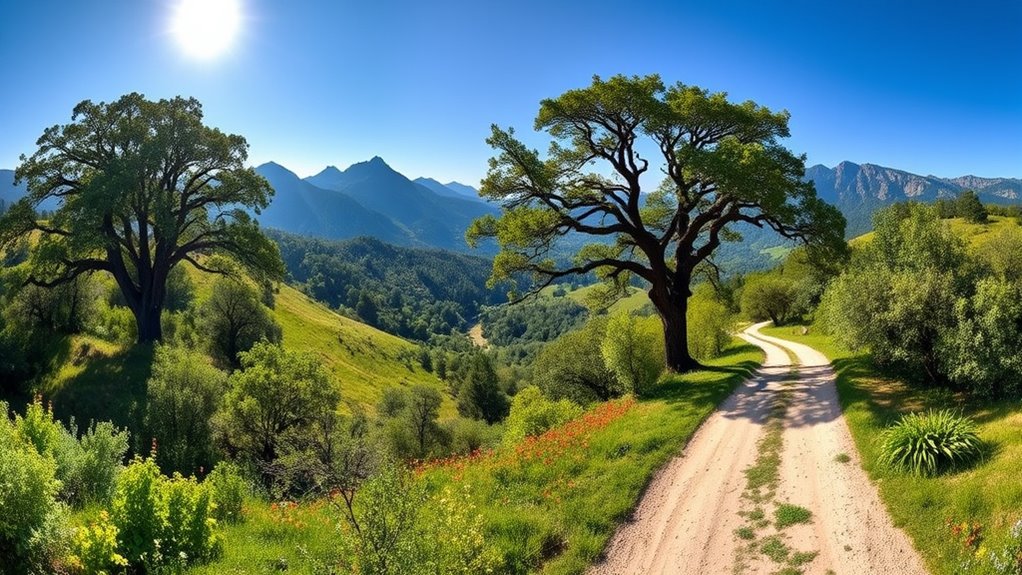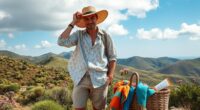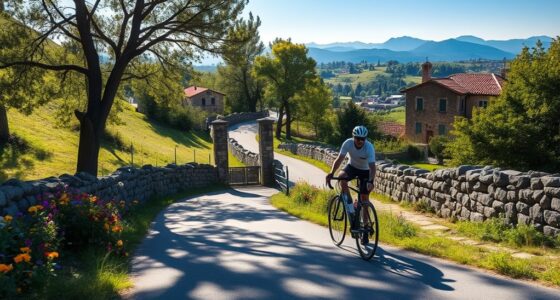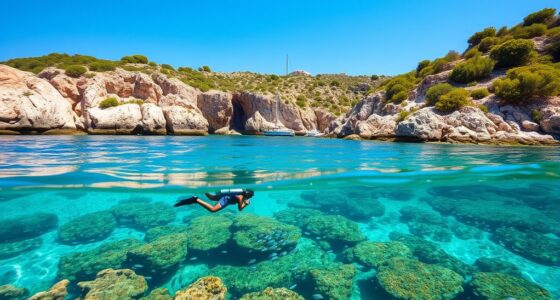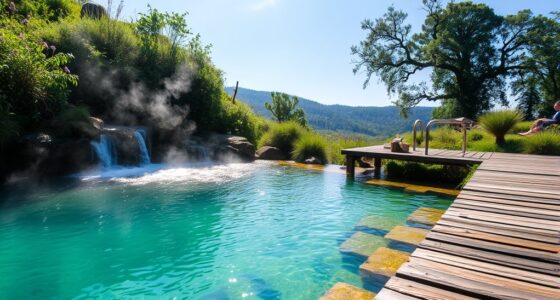Near Ittiri, you can explore stunning natural parks like Porto Conte Regional Park, with its cliffs, beaches, and forests perfect for hiking and wildlife spotting. The nearby Asinara Island offers unique marine protected areas for snorkeling and exploring rare species. Sulcis Park and Monte Linas-Marganai boast dense forests and diverse ecosystems, while Bidderosa Park features pristine beaches. If you keep exploring, you’ll discover even more hidden gems and outdoor adventures waiting for you.
Key Takeaways
- Porto Conte Regional Park is the closest major natural protected area to Ittiri, offering beaches, cliffs, and inland forests.
- Asinara Island Marine Protected Area is accessible for snorkeling and diving, located northwest of Ittiri.
- Sulcis Park features diverse ecosystems and birdwatching opportunities, approximately 150 km southwest of Ittiri.
- The Gennargentu National Park, Sardinia’s largest, is about 150 km southeast, with mountains and wildlife.
- Monte Linas-Marganai-Oridda-Montimannu offers forest trails and panoramic views, roughly 120 km south of Ittiri.
Porto Conte Regional Park: Coastal Cliffs and Forest Trails
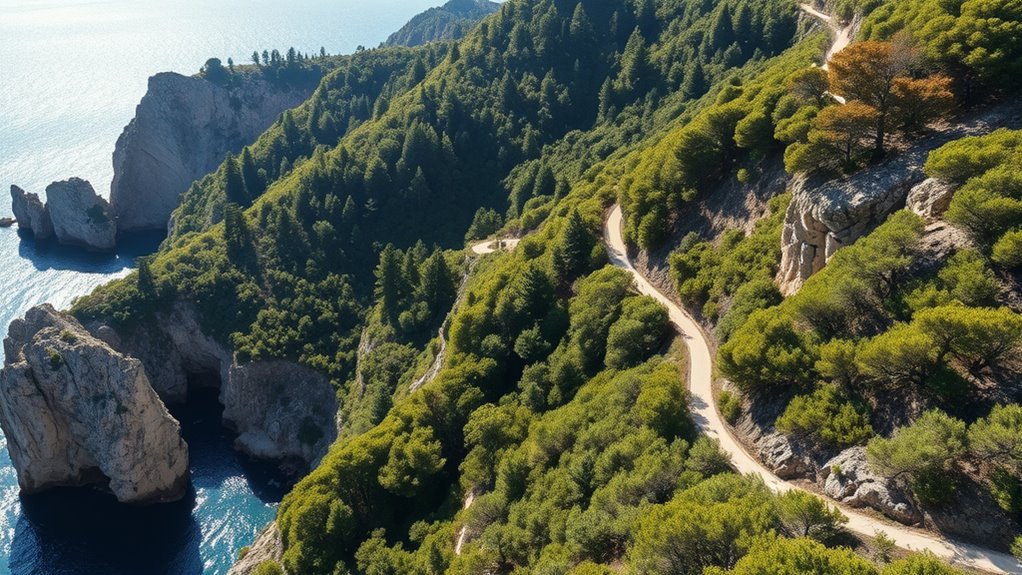
Nestled near Alghero in northwestern Sardinia, Porto Conte Regional Park offers a stunning blend of coastal cliffs and lush inland forests that invite exploration. Covering about 5,000 hectares, it features 60 kilometers of shoreline with sandy beaches and dramatic craggy cliffs. Major highlights include Capo Caccia and Punta Giglio promontories, which frame the serene Porto Conte bay. You can admire the karst cliffs dropping sharply into the sea and explore marine caves like Neptune’s and Nereo’s. Inland, the Mediterranean oak forests and scrubland support diverse wildlife, from Sardinian partridges to kestrels. Trails wind through forests, along cliffs, and past secluded beaches like Mugoni. Whether hiking, birdwatching, or sightseeing, the park’s landscapes promise unforgettable experiences at every turn. Part of Sardinia’s Green Train route, the park is easily accessible for visitors seeking natural beauty and ecological richness. The area’s biodiversity is enhanced by the presence of protected habitats that support numerous endemic species.
Asinara Island: A Sanctuary for Rare Species and Marine Activities
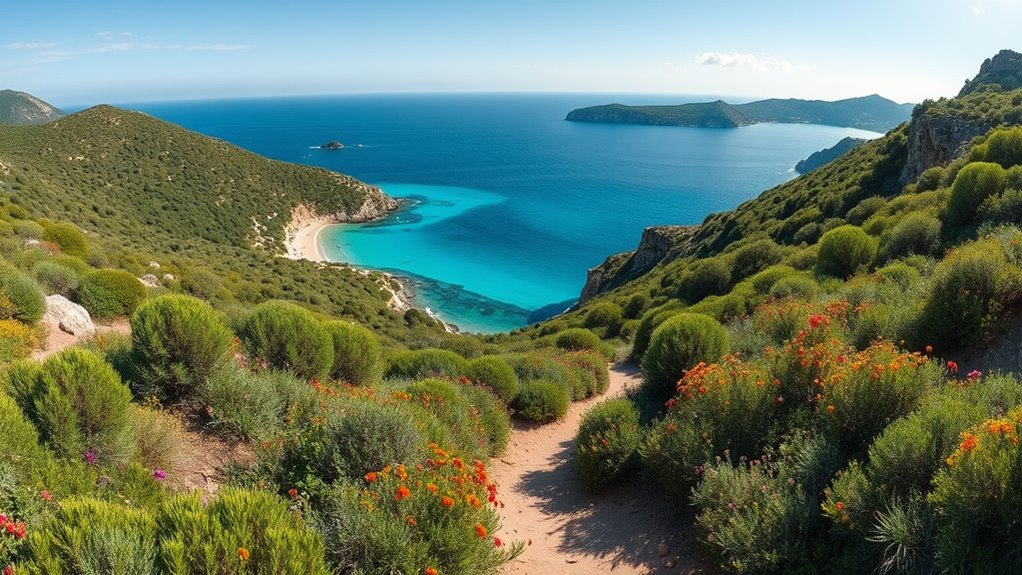
On Asinara Island, you can witness rare species like the protected albino donkeys and explore vibrant marine life in a carefully managed protected area. The island offers opportunities for responsible marine activities, such as snorkeling and boat trips, within strict regulations. By visiting, you help support conservation efforts while experiencing a unique ecosystem teeming with biodiversity. The island is part of a larger network of marine protected areas that play a crucial role in preserving Sardinia’s rich environmental heritage.
Rare Species Conservation
- Unique native plants like Centaurea horrida
- Endangered marine species like Patella ferruginea
- Introduced animals like wild boars and cats
- Bird migration studies and habitat monitoring
- Legal protections under Italian law
- Conservation efforts include diverse plant designs to restore native flora and promote biodiversity.
Marine Recreation Opportunities
Exploring the marine environment around Asinara Island offers a unique blend of recreation and conservation. You can join small-group boat and catamaran tours from Stintino, enjoying snorkeling in secluded coves within the Marine Protected Area. These excursions often include local Sardinian seafood lunches and refreshments, with itineraries tailored to weather conditions for safety. The clear waters teem with Mediterranean fish, octopuses, sea urchins, and coral, making snorkeling and diving popular activities. Dive schools in Cala d’Oliva cater to all skill levels, and hotspots like Cala Arena and Cala Sant’Andrea offer vibrant underwater landscapes. You can also sail, kayak, or paddleboard around Asinara, exploring hidden coastlines and observing wildlife—all while respecting protected zones to preserve this ecological sanctuary. Additionally, understanding the marine ecology of the area can enhance your appreciation and responsible enjoyment of these protected waters.
Sulcis Park: Diverse Ecosystems and Birdwatching Opportunities

Sulcis Park offers a remarkable variety of ecosystems, making it a haven for nature enthusiasts and birdwatchers alike. You can explore lush mountains, dense forests, and rugged coastal cliffs, each hosting unique plant and animal species. The park boasts one of Europe’s largest Mediterranean evergreen forests, filled with mastic, euphorbia, and endemic plants like Centaurea Horrida. Birdwatchers will delight in spotting rare species such as peregrine falcons, golden eagles, and seabirds like Calonectris diomedea and Hydrobates pelagicus. The diverse habitats support breeding grounds and migratory stopovers, offering excellent opportunities for observing raptors soaring above treetops or seabirds around cliffs. Protected status guarantees the preservation of this rich biodiversity and scenic landscapes for ongoing exploration. Additionally, conservation efforts play a crucial role in maintaining the park’s ecological integrity and supporting species survival.
Monte Linas-Marganai-Oridda-Montimannu: Forest Conservation and Wildlife
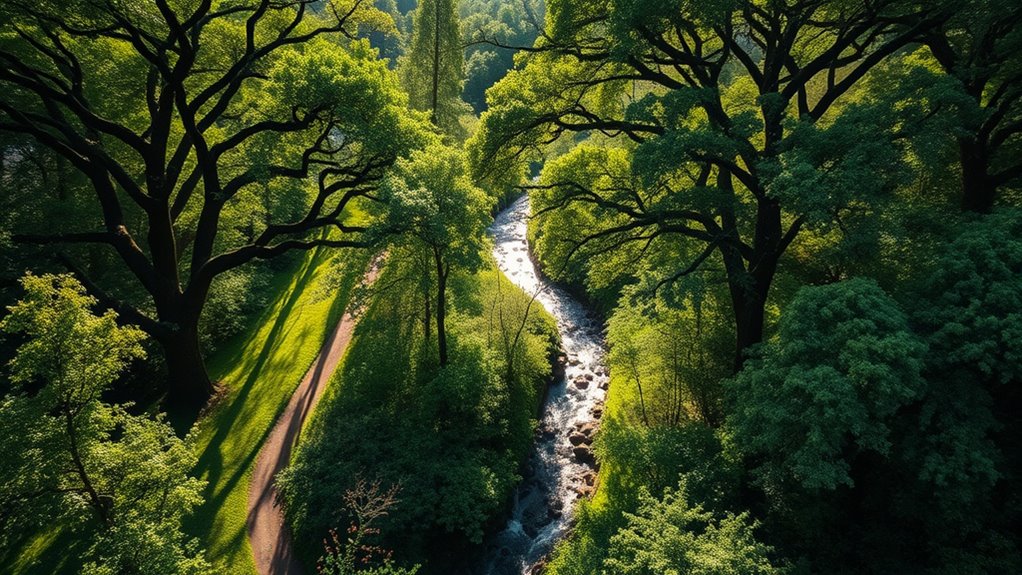
As you explore Monte Linas-Marganai-Oridda-Montimannu, you’ll see how the Sardinian deer find a safe habitat amid the park’s diverse forests. The protected woodland areas and varied terrain make for excellent trail options for nature walks and wildlife observation. Keep an eye out for these unique species as you enjoy the lush scenery and peaceful trails. The region has a long history of conservation efforts aimed at preserving its rich biodiversity since at least 1852. Understanding the importance of biodiversity conservation helps highlight the ongoing efforts to protect such vital ecosystems and species.
Sardinian Deer Habitat
Have you ever wondered what makes the Monte Linas-Marganai-Oridda-Montimannu area an essential habitat for Sardinian deer? This region’s ancient granite formations, dating back 300 million years, create a rugged landscape perfect for their survival. The diverse forests, including holm oak, cork oak, and reforested pines, provide ample food and shelter. The 4,600-hectare Montimannu Forest offers pristine landscapes, water sources like the Muru Mannu waterfalls, and microhabitats on steep slopes and gorges. You’ll find a rich mix of wildlife, from mouflons and wild boars to predators like foxes and eagles. Efforts like ecological corridors and conservation projects help maintain population health and habitat connectivity. This protected area is also home to a variety of bird species, including some rare and endangered ones, supporting the Sardinian deer’s survival and biodiversity.
Forest Trail Exploration
Are you ready to explore the diverse forest trails of Monte Linas-Marganai-Oridda-Montimannu? As you hike, you’ll encounter dense oak and ilex groves, home to endemic plants and wildlife like Sardinian deer. The trail network, including the challenging Alta Via del Linas, takes you along mountain ridges and past waterfalls such as Muru Mannu. Trails are maintained by the Forestas Agency, with improved signposting for safety and orientation. You’ll enjoy panoramic views over southwestern Sardinia and the Campidano plain while steering through steep slopes and rugged terrain. These paths interconnect key natural features, encouraging ecotourism and responsible exploration. Conservation efforts protect the fragile ecosystem, supporting diverse fauna and flora, making your trek both exhilarating and environmentally meaningful. The area is also part of the Gennargentu National Park, which further emphasizes its ecological significance and commitment to preservation. Additionally, the maintenance and protection of these trails contribute to the sustainable tourism goals promoted within protected areas.
Sette Fratelli-Monte Genis: Dense Forests and Wilderness Experiences
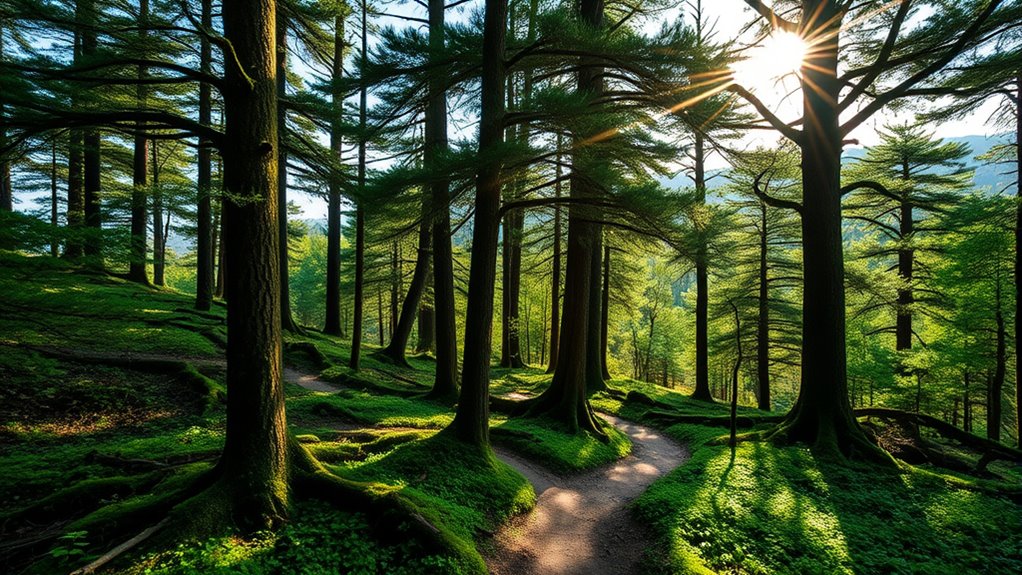
Nestled in southeastern Sardinia, the Sette Fratelli-Monte Genis Regional Park offers an immersive wilderness experience through its dense forests and rugged mountainous terrain. You’ll find granite peaks like Punta Serpeddì and Monte Genis, surrounded by lush valleys and winding rivers. The park’s diverse plant life includes strawberry trees, myrtle, heather, junipers, and holm oaks, creating a vibrant Mediterranean landscape. Wildlife abounds here, with wild boars, Sardinian deer, wild cats, and soaring birds like golden eagles and peregrine falcons. You can explore numerous hiking trails, visit the botanical garden, or observe Sardinian deer in their enclosure. The park’s protected status and ranger stations make it accessible while preserving its pristine environment. Embrace the Boho Style by exploring the natural beauty and rugged landscapes that inspire a free-spirited lifestyle.
Bidderosa Natural Park: Pristine Beaches and Seasonal Coastal Beauty
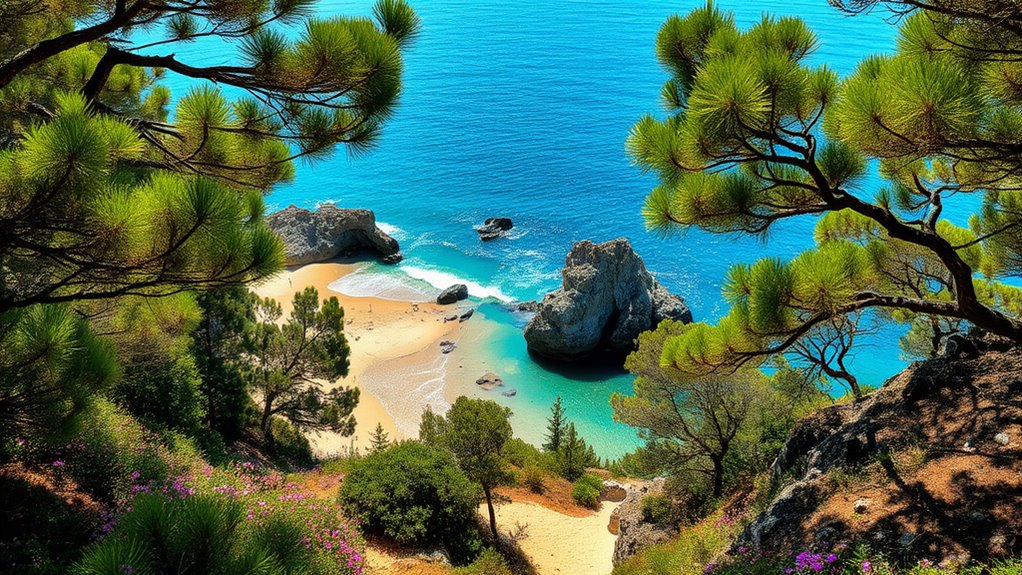
Located on Sardinia’s east coast within the Gulf of Orosei, Bidderosa Natural Park offers a stunning coastal escape with five pristine coves of soft white sand and crystal-clear waters. Covering 860 hectares, the park features lush woods, Mediterranean scrub, granite formations, and two ponds that support diverse wildlife. You can access it via SS 125, but note that from May to October, car and motorbike entry is restricted, though biking and walking are permitted. Many visitors arrive by foot or enjoy a short swim from Cala Ginepro at low tide. Each cove has its own charm, with coves 2 and 3 forming extended beaches, perfect for relaxing or family outings. The park’s protected status guarantees its natural beauty remains pristine, offering a peaceful, scenic coastal retreat. The protected status ensures the preservation of its unique landscape. Additionally, the park’s ecological significance highlights its importance for native species conservation.
Exploring Sardinia’s Coastal and Mountain Reserves
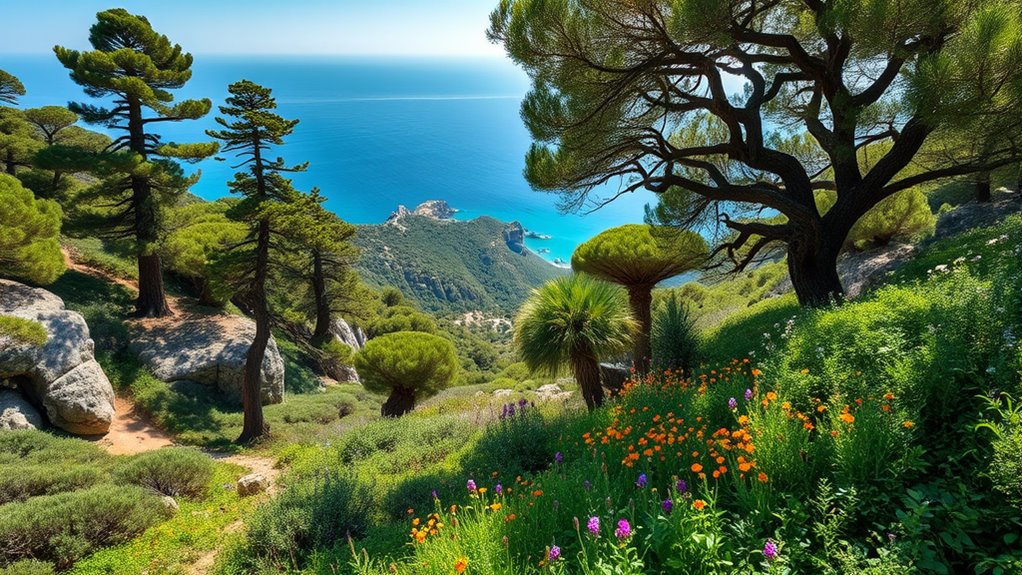
Sardinia’s coastal and mountain reserves offer a diverse range of outdoor adventures and breathtaking scenery. You can hike rugged mountain trails in Gennargentu National Park, home to Sardinia’s highest peak at 1,834 meters, where golden eagles and wild cats roam. In the Monte Linas-Marganai-Oridda-Montimannu Park, explore dense forests, spot Sardinian deer, and walk shaded trails alongside streams. Sulcis Park presents a mix of Mediterranean maquis, oak forests, and birdwatching opportunities, including griffon vultures. Off the northeast coast, the La Maddalena Archipelago invites you to snorkel in crystal-clear waters, discover coral reefs, and relax on pink beaches like Spiaggia Rosa. These reserves promise vibrant ecosystems, panoramic views, and unforgettable outdoor experiences. Conservation efforts help preserve these unique habitats for future generations to enjoy.
Tips for Visiting Sardinia’s Natural Protected Areas
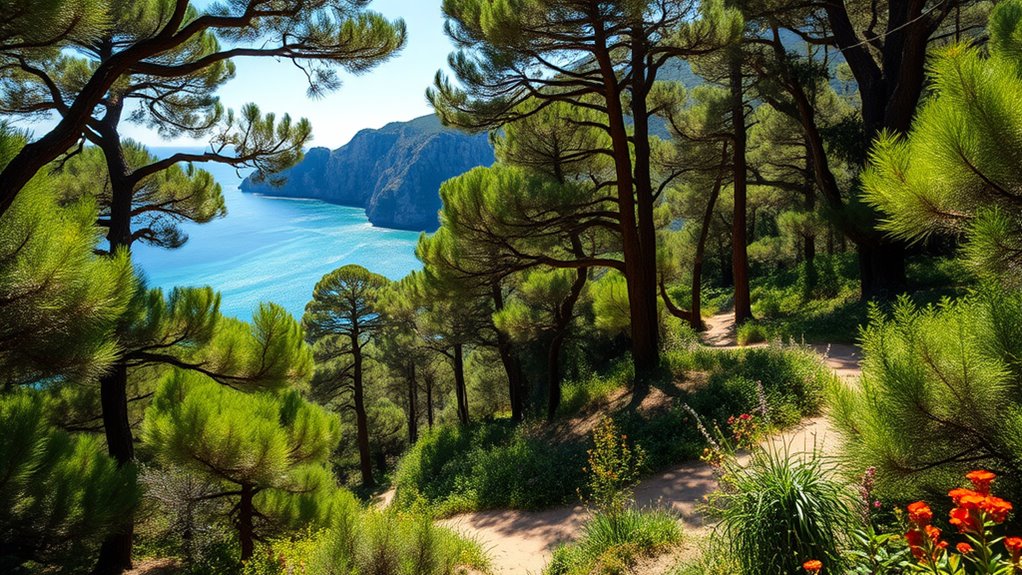
To make the most of your visit to Sardinia’s natural protected areas, planning ahead and choosing the right timing are essential. Visit during late spring to summer for the best weather and biodiversity spotting, but consider spring or autumn for milder temperatures and active wildlife, like albino donkeys in Asinara. Early mornings or late afternoons are ideal for wildlife sightings while avoiding midday heat. Weekdays outside holidays tend to be less crowded, enriching your experience. The island’s national and regional parks are managed to preserve their unique ecosystems and biodiversity, ensuring that visitors can enjoy unspoiled environments. Additionally, understanding the importance of eco-friendly practices can help protect these delicate habitats for future visitors.
Frequently Asked Questions
What Are the Best Months to Visit Sardinian Parks?
You should visit Sardinian parks during spring or fall for the best experience. In April and May, you’ll enjoy mild weather, blooming wildflowers, and fewer crowds, perfect for hiking and exploring. September and October also offer warm temperatures, clear skies, and less tourist traffic, making outdoor activities more enjoyable. Summer can be too hot and crowded, while winter may be too cold for outdoor adventures.
Are Guided Tours Available in These Protected Areas?
Guided tours are definitely available in these protected areas. You can join expert-led walks, wildlife observation, boat trips, and snorkeling adventures. Most parks require booking in advance, and tours often start from nearby towns. Guides focus on conservation, local ecology, and history, offering you a richer experience. Accessibility varies, but many parks provide options for different fitness levels. Booking ahead guarantees you a spot on these educational and exciting tours.
Can I Access All Parks by Public Transportation?
Think of public transportation near Ittiri as a delicate thread connecting you to the parks—thin and often frayed. Sadly, you can’t rely on it to reach all parks directly. Most require a private car or organized tours. With limited bus routes and infrequent services, you’re better off renting a vehicle or joining a guided trip. Public transit just isn’t designed for hassle-free park visits in this area.
What Wildlife Species Are Most Commonly Seen in These Parks?
You’re likely to see a variety of wildlife species in these parks. Birds such as raptors, seabirds, and migratory waterfowl are common, especially near wetlands and coastal cliffs. You might also spot endemic reptiles and amphibians like Sardinian tree frogs and lizards in wetlands and forests. Small mammals like wild boar, mouflon, and endemic species such as Sardinian donkeys are often visible, especially in protected areas like Asinara Park.
Are There Specific Regulations for Camping or Picnicking?
Your curiosity about camping and picnicking regulations is essential for safeguarding extraordinary ecosystems. You’ll find strict rules—camp only in designated zones, avoid open fires, and carry out all waste—to protect fragile wetlands and biodiversity hotspots. Unauthorized camping is heavily restricted, and seasonal limits on picnics help prevent disturbance. By following these guidelines, you guarantee these awe-inspiring natural wonders remain pristine, allowing future generations to marvel at their beauty.
Conclusion
Discovering Sardinia’s natural parks near Ittiri feels like stepping into a paradise that’s bursting with life and breathtaking beauty. From coastal cliffs to lush forests, each reserve offers an unforgettable adventure that’ll leave you in awe. So, lace up your hiking boots, breathe in the purest air, and immerse yourself in these incredible landscapes. Trust me, you won’t believe a place this stunning exists on Earth—it’s truly a nature lover’s dream come true!
